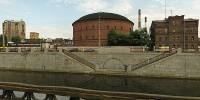
Obvodny Canal and Old Gasholder
Saint-Petersburg, Russia
June, 17, 2005 UTC 12:00 (local time 18:00)
© 2005 Andrew Varlamov, All Rights Reserved.
Perhaps You can smile but 5 days later (January 9, 2005) the Neva made present for Saint-Petersburg - the next flood (panoramas of the flood shooted by Vladimir Leonidovich Shirokov are located here).
Really the Obvodny Canal together with defensive wall was constructed in 1769-1780 by project of engineer Lev Lvovich Carbonier d'Arsit (in Russian Карбонье д'Арсит Лев Львович) between the Ekateringofka river and the Ligovskiy Canal. In 1805 engineer Ivan Kondratievich (Johan Konrad) Gerard began construsion of east section of the Obvodny Canal, deepening and widening old river-bed (crease). Works were continued in 1816-1833 with supervision of engineers Pierre-Dominique Bazaine and Emile Clapeyron (You can find his name ingraved on the Eiffel Tower). The Obvodny Canal became south frontier of Saint-Petersburg.
In 1835 shipping was opened along the whole it's length. Growth of ship's tonnage caused shipping to suspend in early 1900s. Only in 1930s canal's reconstruction began with supervision of architect K.M.Dmitriev and engineer I.B.Tarasenko. Reconstruction was interrupted by WWII. Before the WWII the Obvodny Canal was cleaned and deepened, concrete embankment was built from Baltiskiy Railway Station to Prospekt Gaza. In 1960 it was submitted a proposal to cover up canal with earth and transfrom it into motorway. Fortunately the Obvodny Canal escaped the lot of the Ligovskiy Canal (which was hidden under ground in 1895). It was chosen project of subsequent reconstruction including projects of new bridges and embankments.
Nowadays the Obvodny Canal is crossed by 19 city bridges and 2 railway bridges. The both railway bridges (under Moscow-Petersburg and Vitebsk-Petersburg railways) are called "American" in honor of american engineer Herman Haupt. (Please don't worry, Haupt never visited Russia. The first bridge named "American" was built in the middle of the 19th century. It crossed the Obvodny Canal to join Kremenchugskaya street and Glukhoozerskoye high road. The bridge obtained its name because it was constructed according to Haupt system and was built of wooden belts, diagonal braces and vertical metallic tension bars. Before 1890 the bridge was destroyed, then new bridge was built. In 1940 the bridge renamed Atamanskiy. But people saved its old name "American" for railway bridges). You can see in the panoramic view one of them - green suburban train is running away to Pavlovsk.
Two visible pedestrian bridges are called Mozhaiskiy (left) and Gazovy (right). Gazovy bridge obtained its name from gas plant. On 15 (27) February 1835 the first joint-stock company in the history of the Russian gas industry, the Company for Gas Lighting St. Petersburg, was founded. At the end of 1835, the first factory in the Russian Empire for the production of lighting gas was constructed near the Obvodnoy Canal. Pit coal was used as the raw material, brought in by ship from Cardiff (Great Britain). (Citied from "Oil of RUSSIA" magazine No.2, 2005)
Gas was collected into gasholders - giant masonry round towers with several narrow windows and covered by metallic cupolas. Gasholder visible on the panorama is 40 meters in diameter and stands 20 meters tall. Four gasholders was built in 1872 by architect Rudolf Bogdanovich Berngard and engineer Wilhelm Rudolfovich Berngard, his son (In other handbook 1884 year is mentioned). 5 years later, in 1877 Rudolf Berngard took part in construction of cupola for the first stationary stone circus in Russia, its diameter was equal to 49.7 m.
In early 1990s State Unitary Enterprise "Lengiproinzhproject" submitted conception of overpass highway construction over the Obvodny Canal. Today there are two versions of the future project : 1) construction of highway over the canal consisting of 6 traffic lanes (3 lanes per each direction) 5-6 km in length from the Neva to Moskovsky Prospekt and construction numerous branches to crossed streets 2) creation of semiclosed tunnel after partial covering of the Obvodny Canal. It is easy and cheap to realize the first version of the project. Experts tell that technical conditions of embankments near "american" bridges doesnt permit to widen and to deepen them.
Future of old gasholder is more misty - today it used as warehouse (like Russian churches after October Revolution of 1917), but up-do-date european practice shows successfull examples of gasholder's renovation. The place is not far from city center - in the end of the street (named Vereiskaya) laying opposite gasholder small golden dome of St.Isaacs Cathedral is visible.
Software: Realviz Stitcher 4.0, Adobe PhotoShop 7.0, PanoCube
Some words about other ideas for the theme of event which remain un-realized by me: Submarine D-2 "Narodovolets" (http://www.museum.navy.ru/fillst_e.htm#lodka ),
Water Tower - now Museum of water (opposite Tavricheskiy Palace),
Fountain "Dairy Woman" (Perette) in Pushkin,
Fountain near Old Admiralty.
I am glad that i've found the subject which helped me to tell long story reflecting interesting links between known builings, bridges and rivers. I made an attempt to write story which would be similar to water drop which shows whole surrounding world through itself.
Возможно, Вы улыбнетесь, но 5 дней спустя (9 января 2005 года) Нева сделала Санкт-Петербургу подарок - очередное наводнение (панорамы этого наводнения, снятые Владимиром Леонидовичем Широковым, можно увидеть здесь).
Фактически Обводный канал с оборонительным валом был сооружен в 1769-1780 годах по проекту инженера Льва Львовича Карбонье д'Арсит от реки Екатерингофки до Лиговского канала. В 1805 году инженер Иван Кондратьевич (Иоган Конрад) Герард начал прокладку восточного участка Обводного канала, углубление и расширение старого русла. Работы были продолжены в 1816-1833 годах под руководством инженеров П. П. Базена и Б. П. Э. Клапейрона (его имя можно найти выгравированным на Эйфелевой башне). Обводный канал стал южной границей города.
В 1835 навигация открылась по всей длине канала. Рост осадки судов привел к прекращению судохоства в начале 20 века. Лишь в начале 1930-х началась реконструкция канала по руководством архитектора K.M.Дмитриева и инженера И.Б.Тарасенко. Реконструкцию прервала война. Перед войной канал очистили и углубили, между Балтийским вокзалом и проспектом Газа построили бетонную набережную. В 1960 предлагалось засыпать канал и превратить его в автомагистраль. К счастью, Обводный канал избежал судьбы Лиговского канала (спрятанного под землю в 1895 году). Был выбран проект дальнейшей реконструкции, включающий строительство новых мостов и набережных.
Сегодня Обводный канал пересекают 19 городских мостов и 2 железнодорожных моста. Оба железнодорожных моста (под Московской и Витебской железными дорогами) зовутся "американскими" в честь американского инженера Германа Гау. (Пожалуйста, не беспокойтесь, Гау никогда не бывал в России. Первый мост, названный "американским", был построен в середине 19-го века. Он пересек Обводный канал, чтобы соединить Кременчугскую улицу и Глухоозерное шоссе. Свое имя он получил потому, что был спроектирован по системе американского инженера Гау и состоял из деревянных поясов и раскосов с металлическими вертикальными тяжами. Перед 1890 годом мост был разрушен, потом был построен новый мост. В 1940 году мосту получил новое имя - "Атаманский". А его старое имя "американского" люди сохранили для железнодорожных мостов). На панораме виден один из них - зеленая электричка уезжает с него в Павловск.
Два других видимых моста для пешеходов называются Можайским (слева) и Газовым (справа). Газовый мост получил свое имя от газового завода.
15 (27) февраля 1835 года было основано первое в истории русской газовой промышленности Общество освещения газом Санкт-Петербурга. В конце 1835 года на Обводном канале был построен первый в России газовый завод по производству газа для освещения. Для выработки газа использовали уголь, привозимый морем из Кардифа (Великобритания). (Переведено из журнала "Oil of RUSSIA" No.2, 2005)
Газ собирался в газгольдеры - гигантские круглые кирпичные башни с редкими узкими окнами, перекрытые металлическими куполами. Газгольдер , видимый на панораме, имеет 40 метров в диаметре и возвышается на 20 метров. Четыре газгольдера были построены в 1872 году архитектором Рудольфом Богдановичем Бернгардом и инженером Вильгельмом Рудольфовичем Бернгардом, его сыном (в другом справочнике указан 1884 год). 5 лет спустя, в 1877 Рудольф Бернгард принял участие в строительстве купола первого в России стационарного цирка, диаметр которого был равен 49.7 метра.
В начале 1990-х гг ГУП "Ленгипроинжпроект" представил концепцию строительства эстакады над Обводным каналом. В настоящее время существует два варианта реконструкции Обводного канала: строительство 6-полосной эстакады над ним (по 3 полосы в каждую сторону) длиной 5-6 км на участке от пр. Обуховской обороны (там необходимо будет построить сложную развязку) до Московского проспекта с многочисленными съездами с нее на прилегающие магистрали и вариант создания полузакрытого тоннеля путем частичной засыпки Обводного канала. При строительстве эстакады предполагается, что движение по существующим набережным будет сохранено. Строительство эстакады намного дешевле и проще в техническом отношении. Кроме того, ее содержание по сравнению с содержанием тоннеля будет намного дешевле. Кроме того, как уверяют специалисты, набережные около "американских" мостов невозможно ни расширить, ни углубить по техническому их состоянию.
Будущее газгольдера более туманно - сегодня он используется как склад (как русские церкви после Октябрьской Революции), но современная европейская практика показывает успешные примеры реконструкции газгольдеров. Его месторасположение находится недалеко от центра города - в конце улицы (Верейской), лежащей против газгольдера, виден золотой купол Исакиеевского собора.


 Tap or click the zoom icon in the bottom right corner of the picture to switch between in-page and fullscreen view
Tap or click the zoom icon in the bottom right corner of the picture to switch between in-page and fullscreen view